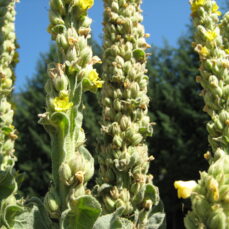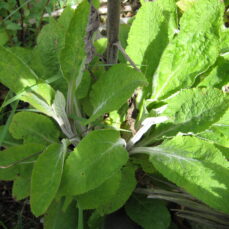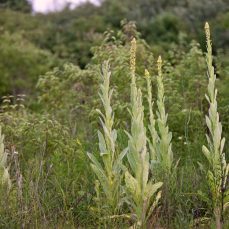
Management category
Squamish
Whistler
Pemberton
Vector of spread
Synonyms
Great mullein is also known as:
- Common mullein
- Cow’s lungwort
- Velvet plant
- Adam’s flannel
- Aaron’s rod
ID Characteristics
Flowers: Dense clusters of small sulphur yellow flowers. Each flower is 5-lobed and approx. 1.5 – 3 cm across.
Stems: Tall, erect, hairy stems which can grow up to 2 m tall. Through the summer, the stems are green, whereas in the winter, they are brown.
Leaves: Great mullein leaves are 10 – 45 cm long, lance-shaped, grey-green, and woolly. Basal leaves (closest to the ground) are arranged in a rosette. Stem leaves grow in an alternate pattern.
Roots: Root size and depth may vary by site, but great mullein generally has a relatively shallow taproot.
Fruits: Small, woolly, egg-shaped capsules that contain many seeds. The brown seeds are 0.5 – 0.7 mm across.
Similar Species
Invasive
Common foxglove (Digitalis purpurea): Foxglove leaves are more pointed and leathery than great mullein’s.

Common comfrey (Symphytum officinale): Its leaves are larger and less hairy than great mullein’s.

Native
Moth mullein (Verbascum blattaria): While it is from the same family as great mullein, moth mullein is smaller and has white flowers.

Habitat and Origin
Great mullein was introduced from Eurasia to North America in the mid-1700s as an ornamental plant. Evidence indicates that great mullein use ranged from medicinal and ceremonial to fish poison!
Great mullein thrives on open, disturbed land. It is intolerant to shade and does not compete well with vibrant, established native plant communities. Great mullein is often the first species to appear at burned sites, along railroads, fence rows, fields, pastures, roadsides and gravel pits.
How It Spreads
Great mullein reproduces by seed. Each seed capsule (see Fruits section) contains hundreds of seeds, so a single plant may develop as many as 240,000 seeds. Moreover, mullein seeds are persistent: one study successfully germinated seed samples within soil dated to 1300 A.D.!
Great mullein has no morphological adaptations for long-distance seed dispersal; therefore, most seeds fall very close to the parent plant. However, great mullein’s long-lived seed bank makes transport of contaminated soil a possible long-distance vector of spread.
Impacts
Ecological:
- Reduces biodiversity.
- Unpalatable to livestock due to its woolly leaves.
Economic:
- Established stands are extremely difficult and costly to control (see Reproduction section).
- Reduces crop or forage yield.
Health:
- Star-shaped, felted hairs can cause skin irritation.
Stop the Spread
Great mullein is widespread in the Sea to Sky region, and site-scale control options are either ineffective or futile. While great mullein is not included in SSISC’s control programs, we recommend avoiding its cultivation.
Learn to identify great mullein: Use the images presented on this profile page.
What to do if you spot it: You can report any great mullein sighting by visiting our reporting page.
DO:
- Regularly monitor properties for weed infestations.
- Remove plant material from any equipment, vehicles or clothing used in infested areas and wash equipment and vehicles at designated cleaning sites before leaving infested areas.
- Ensure soil and gravel are uncontaminated before transport.
- Minimize soil disturbances (e.g., use grazing plants that prevent soil exposure from overgrazing), and use seed mixes with dense, early colonization (e.g., alfalfa or barley) to re-vegetate exposed soil and resist invasion.
- Ensure invasive plant (particularly flowering heads or root fragments) are bagged or covered to prevent spread during transport to designated disposal sites (e.g., landfill).
DO NOT:
- Plant great mullein in a garden, no matter how well-contained its enclosure may seem.
- Move soil that has been contaminated with great mullein.
- Unload, park, or store equipment or vehicles in infested areas; remove plant material from any equipment, vehicles, or clothing in such areas and wash equipment and vehicles at designated cleaning sites before leaving infested areas.
- Compost great mullein!
Control
Mechanical:
- Hand-pull plants that grow on loose soil; for harder soils, use a spade or shovel to cut the taproot.
- Try to minimize soil disturbance, since it will encourage seed germination.
- If blooms or seed capsules are present, remove and bag them before disposing of them appropriately.
- Mowing new plants (when they are 30-60 cm tall) can reduce population and seed production for the season, especially in dry years.
Chemical:
- Herbicide application is most effective when the rosettes have 6-12 leaves but before the stem starts to grow, usually in May to mid-June.
- Due to the woolly leaves, the use of a surfactant is recommended.
- Consider re-treating sites more than once to tackle the long-lasting seed bank.
- Aminopyralid + metsulfuron methyl; aminopyralid; metsulfuron methyl; chlorsulfuron; picloram; picloram + 2,4-D; glyphosate; chlorsulfuron + metsulfuron methyl; and aminopyralid + 2,4-D are all considered effective on Great Mullein.
- Note that picloram is not suitable for wet, coastal soils.
- We recommend that any herbicide application is carried out by a person holding a valid BC Pesticide Applicator Certificate. Before selecting and applying herbicides, you must review and follow herbicide labels and application rates; municipal, regional, provincial and federal laws and regulations; species-specific treatment recommendations, and site-specific goals and objectives.
Biological:
Some biological agents exist, including seed-feeding weevils (Rhinusa tetra), curculionid weevil (Gymnaetron tetrum), and mullein moth (Cucillia vergasci), which is currently being studied in the US.
Sea to Sky Distribution
Great Mullein Factsheet
Having trouble viewing the factsheet? Don’t worry, all the information is included on this page. You can also contact us with any questions.
References
- Alberta Invasive Species Council, Common Mullein
- Canadian Science Publishing, “Verbascum Thapsus L. and V. Blattaria” in The Biology of Canadian Weeds
- Electronic Atlas of the Flora of British Columbia, Verbascum thapsus
- Garden Guides, How to Control Common Mullein
- Government of British Columbia, Rhinusa tetra
- Government of Ontario, Weed Identification: Common Mullein
- Lincoln County Noxious Weed Control Board, Common Mullein: Options for Control
- Matthaei Botanical Gardens, Invasive of the week
- Peace River Regional District, Profile of Invasive Plant Species Within the Peace River Regional District
- The Wildlife Trusts, Great Mullein
- UC Davis, “Common and Moth Mullein” in Weed Control in Natural Areas in the Western United States
- US Department of Agriculture Fire Effects Information Systems, Verbascum thapsus














